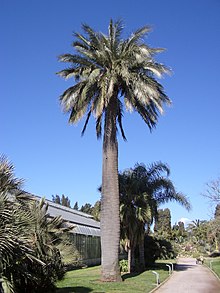Jubaea

Jubaea is a genus of palms with one species, Jubaea chilensis or Jubaea spectabilis, commonly known in English as the “Chilean wine palm” or “Chile cocopalm”, and “palma chilena”[3] in Spanish. It is native to southwestern South America and is endemic to a small area of central Chile between 32°S and 35°S in southern Coquimbo, Valparaíso, Santiago, O’Higgins, and northern Maule regions.
It has long been assumed that the extinct palm tree of Easter Island belonged to this genus as well; however, in 2008, John Dransfield controversially placed it in its own genus, Paschalococos.
The thickest well-documented Jubaea was on the estate of J. Harrison Wright in Riverside, California. Its diameter “at shoulder height” was 66 inches (1.7 m).[4] The largest of several specimens at the Adelaide (South Australia) Botanic Garden in 1889 was stated to be 6 feet (1.8 m) thick at the base.[5] A hollow (but living) Jubaea in the Ocoa Valley near La Campana National Park, Chile is 6 to 7 feet (1.8 to 2.1 m) thick at its base, with no apparent taper in the lower trunk.[6] The largest individual specimen of indoor plant in the world was the Jubaea chilensis at Kew Gardens, which was cut off by staff in 2014 because it grew to the top of its greenhouse.[7] Of the more than 2,600 known species of palms, Jubaea chilensis is the second most massive, exceeded only by the floodplain or river bottom variety of Borassus aethiopum.[8]
The species is partially protected within Chile, although pressures of human population growth and expansion of grazing areas have reduced the population of the Chilean Wine Palm in recent centuries.[9]
